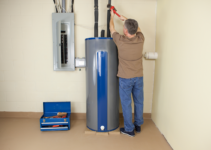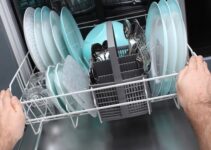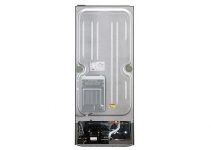A clogged garbage disposal is one of the most common kitchen headaches. Food particles, grease, and other gunk can build up in the grinding chamber and prevent the blades from turning properly. But before you call the plumber, try these DIY methods to unclog your garbage disposal and get it working again.
Summary
Here are the step-by-step instructions for unclogging a jammed garbage disposal using common household items. These include:
- Turn off electrical power at the breaker before attempting any repairs
- Remove the sink splash guard to access the disposal chamber
- Manually extract any debris lodged in the grinding ring or drain opening
- Insert an Allen wrench or screwdriver into the bottom shaft and turn to spin the blades
- Use a specialty garbage disposal wrench to turn the blades clockwise and counterclockwise
- Plunge the drain vigorously to dislodge gunk
- Pour baking soda and vinegar down the drain to react with grease clogs
- Press the reset button if the disposal has one to reset any internal breaker
- Detach and clean out the curved P-trap under the sink
These DIY techniques using common household items can help clear jams in clogged garbage disposals and get them working properly again.
What Causes Garbage Disposals to Clog?
There are several reasons garbage disposals clog up:
- Putting the wrong foods down the disposal – Fibrous foods like celery stalks, corn husks, and onion skins can wrap around the blades and jam them. Starchy foods like potatoes can turn into a thick paste. Bones, fruit pits, and eggshells are also no-no’s.
- Overloading the disposal – Don’t put large amounts of food waste down the drain at one time. Feeding more than the disposal can handle in one sitting will overwhelm the motor.
- Lack of water flow – Running the disposal without enough water doesn’t flush the waste through. Always run cold water when using the disposal.
- Drain pipe issues – A partial blockage farther down the pipes can back up waste and cause the disposal to clog.
- Foreign objects – Silverware, bottle caps, scrub pads and other items can damage blades and lead to jams. Run only food waste into the disposal.

How to Unclog a Garbage Disposal
Try these simple DIY methods to clear clogs:
1. Turn off the power at the breaker
Safety first! Switch the disposal’s circuit off at the breaker box before attempting any repairs.
2. Remove splash guard
Use tongs to pull off the rubber splash guard under the sink, exposing the garbage disposal chamber.
3. Manually extract debris
Use tongs to pull out any visible food particles or foreign objects lodged in the grinding ring or drain opening.
4. Turn wrenches
Insert an Allen wrench or flathead screwdriver into the bottom of the disposal. Turn the wrench back and forth to manually spin and dislodge the blades.
5. Use a disposal wrench
Specialty wrenches made for garbage disposals can penetrate further to free a stubborn jam. Turn the wrench clockwise, then counterclockwise several times.
6. Plunge the drain
Fill the sink halfway, cover the other drain opening, then vigorously plunge up and down for 2-3 minutes to dislodge gunk.
7. Use baking soda and vinegar
Pour 1 cup baking soda down the drain followed by 1 cup vinegar. Let it fizz for 10-15 minutes then flush with hot water. The chemical reaction can help break up grease clogs.
8. Reset garbage disposal
If the disposal has a reset button, push it in until it clicks and remains. This will reset the internal breaker if tripped.
9. Remove and clean the P-trap
Unscrew the curved P-trap under the sink drain. Remove any debris clogging it, then reattach.

When to Call a Professional
If you’ve tried these tips without success, the disposal may need servicing. A pro can inspect the blades and motor, remove blockages, and determine if repairs or part replacements are needed.
For major clogs, leaks, electrical issues or other complex garbage disposal problems, it’s best to call in an experienced plumber to get your unit back in working order.
How to Maintain Your Garbage Disposal
Regular care and maintenance will prevent many clogs and keep your disposal running smoothly:
- Grind only soft foods – Soft fruits, cooked veggies, eggshells and coffee grounds are OK. Avoid hard or fibrous foods.
- Run water before and after use – This flushes food particles down the drain. Let water run for 30 seconds after grinding is finished.
- Avoid grease – Oil and greasy foods will solidify and coat the insides of the disposal.
- Use ice to clean – Grinding ice cubes every couple weeks will scour the inside and sharpen blades.
- Freshen with citrus – Grind citrus peels to deodorize and keep drains fresh smelling.
- Check for foreign objects – Visually inspect the drain opening before turning on the disposal to make sure no silverware or other items have fallen in.
- Clean with baking soda – Pour 1⁄2 cup of baking soda down the drain once a month and let it sit overnight to absorb odors. Flush with water in the morning.
A little bit of prevention will keep your garbage disposal clog-free for years. But even the best-maintained units can fail occasionally. If your DIY efforts don’t get the disposal unclogged, call on a professional plumber to get your unit back in grinding order.
FAQs
Why is my garbage disposal humming but not grinding?
A humming noise means the disposal motor is getting power, but the blades are jammed and unable to spin. Try turning the reset button or insert an Allen wrench to manually turn the blades and free up the jam.
How do you unjam a garbage disposal with a wrench?
Insert an Allen wrench or flathead screwdriver into the bottom center shaft. Turn the wrench clockwise, then counterclockwise several times to manually spin the blades and dislodge anything stuck. Use a specialty garbage disposal wrench for added torque.
What should I do if the garbage disposal reset button keeps popping?
If the reset button won’t stay engaged, unplug the disposal and wait 10-15 minutes to allow the internal overload protector to cool down. Then plug it in and try the reset button again. If it still won’t reset, the internal breaker may need replacing.
When should you replace rather than repair a garbage disposal?
If the motor is burned out, blades are badly damaged, or the body is corroded or cracked, replacement is usually a better option than repairing an old unit. Repairs tend to be complicated and may end up costing more than installing a new disposal.




